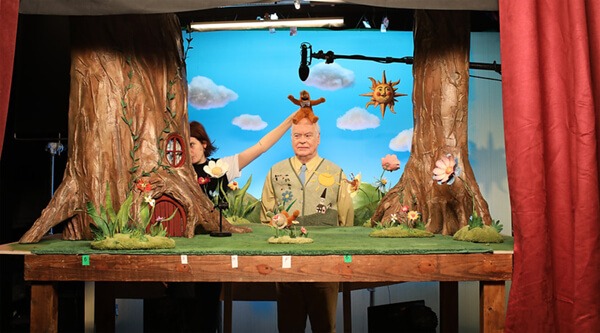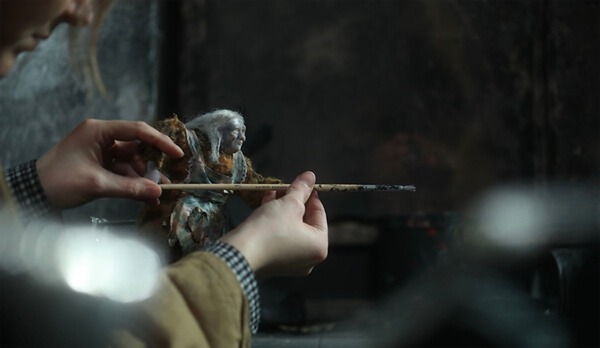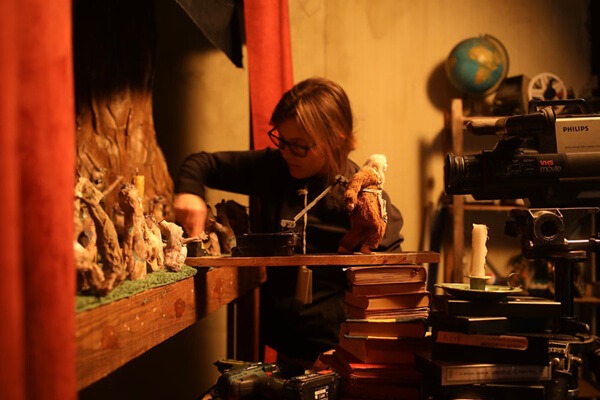Wander to Wonder | Interview with BAFTA-winner Nina Gantz
UPDATE 16/02/2025 – Wander to Wonder has won the BAFTA for British Short Animation and is presently available to watch online in full (see below)
Following a premiere at the 2023 Venice Film Festival and a festival run including screenings at Clermont-Ferrand and Ottawa International Animation Festival with major award wins at Anima Brussels, Cardiff Animation Festival and SXSW among others, Nina Gantz‘s incredible stop-motion short Wander to Wonder has gone from strength to strength and is presently nominated for both an Oscar® and BAFTA.
Produced by Circe Films, Kaap Holland Film, Beast Animation, Les Productions de Milou, Blink Industries, Pictanovo, Netherlands and distributed by MIYU (whose short film roster includes fellow Oscar®-nominees Beautiful Men and Yuck!), Wander to Wonder brings us into a fantastical yet curiously nostalgic world where miniature performers Mary, Billybud and Fumbleton are left rudderless on the set of a children’s television show whose creator has passed away. As the futility of their existence becomes all the more apparent, building to an inevitably bleak conclusion, Mary remains determined that the show must go on.
The film marks Nina’s first short film since her acclaimed NFTS student film Edmond and brilliantly combines live-action and stop-motion to create a bizarre yet authentic piece that interweaves 80s culture with elements of comedy, folk and analogue horror. Ahead of this year’s BAFTA ceremony which takes place on February 16th, Skwigly were thrilled to catch up with the director and dive deep into the film’s backstory and production.
The film seems to show a darker side to nostalgia and explores feelings of grief. Where did the original idea for the film come from?
Since discovering the work of Ray Harryhausen in films such as Jason and the Argonauts and Attack of the Puppet People, I’ve had a fascination with combining live-action and stop-motion. I started thinking about what kind of world I could create if I combined these two mediums together, then after graduating from the National Film and Television School, I came up with the idea for a short film about a kids TV show with Simon Cartwright. We got very interested in where the story would go if we went behind the scenes and treated it like a family drama, with actual little humans inside the puppets. Uncle Gilly, the presenter, played a much bigger role in early versions of the script.
During seven years of development, trying to get the money together and COVID happening, Simon went on to another project. This gave me the opportunity to reflect on it and I gravitated to a much more personal version of the story. I also got the Dutch screen writer Daan Bakker involved, because I had already been working with the story for so long in my head that I needed someone to shake it up a little bit. I also got way more interested in the world of the little people in the studio and how they would survive on their own in a space like th at. During the time of the last rewrite, me and my husband also were taking care of someone who needed palliative care and when he passed away I saw how differently everyone deals with loss. And this is something that found its way into the three characters in Wander To Wonder. Mary clings on to the past and tries to keep the legacy going. Fumbleton feels kind of freed. He finally can show off his skills as a serious Shakespearean actor, while Billybud buries his head in the sand and focuses on what he knows best, which is juggling.
So this puzzle of development took 8 years but that did mean the story grew with me. I kept changing it to make it fit with my own journey as a filmmaker. And although 8 years was really too long, it did make the story rich and gave the characters depth. I guess that’s the bonus of working on something for so long!
Your films often play with a paradoxical feeling of whimsy and darkness, which, to me, always feels completely in keeping with the medium of stop-motion. As simultaneously cute, but also creepy. Where do you feel this desire to play with these two things, in this medium, comes from?
You can’t tell a heavy story like this without a little lightness. I think it also helps to hit the viewer even harder – or rather, it will hit them in an unexpected way, which is always interesting. And that’s also what I find interesting when I watch films. The two combined work best to convey the message.
This is your first independent film since Edmond, and as we’ve discussed above this took a long time to be made and from my understanding, it had quite a complex funding situation. Can you tell us a little bit more about the journey you went on to get the film made?
Edmond was my graduation film and I now realize how much easier it is to make a film in film school because you have your crew available for advice and they’re your friends and they’re there for you all year. It doesn’t really happen like that outside of film school. You first need to find a good team and then you need to put your trust in them, which can be a bit daunting. For Wander to Wonder we had to work in a co-production between four countries, which is really insane for a short animated film. I learnt that a lot more people want to say something about the film and you also have to work with people in all four countries.
I made the animatic in the UK, where I live and I made the puppets in the Netherlands. We had to film in a certain part of Belgium, with people from that region and the post-production had to be in the South of France, which is where the money came from.
Altogether it had its pros and cons. The communication was a challenge, however, I got to know loads of amazing people in other countries that love making stop-motion films.
Was the production quite tight then, after the lengthy pre-production stage?
Yes! it took about a year in total to make. That included making the puppets, constructing the sets and then five months of filming on two sets with three months in post-production.
The performance in the puppets is so nuanced. Could you talk a little about how you achieved this as a director?
Fortunately we were able to film the voice recording session with Toby Jones and Amanda Lawrence so we had a lot of wonderful reference footage. In addition to this, I made a lot of detailed videos of myself and my DOP (or my husband!) acting stuff out to give to the animators a reference for expression and body movement. I love giving reference footage because it makes it really clear how I see the shot as a director and it helps with timing. I had a number of animators working on the film who each worked in different ways. Most of them used the reference footage and then added personality to it whereas some work from experience and intuition, which can also result in beautiful performances.

Image courtesy of Nina Gantz
I was lucky enough to see the puppets in real life, and they’re really beautiful. Can you talk a little bit about the choices you made when it came to the look of the puppets and the overall film?
The size of the sets really informed the size of the puppets. The character design had to fit with the Uncle Gilly character (live action) and I wanted to work with real props and life-size sets, which meant we had to make them much smaller than normal stop-motion puppets. Also, because there is dialogue in the film and we needed quite a lot of expression in their faces, the most suitable option was to work with replaceable 3D-printed faces.
I had never worked with 3D printing before, and I had to find a look that I was happy with, which resulted in a very long research period. It was quite interesting because I knew they had to be fairly realistic, but then I also wanted it to clearly feel like stop-motion. A tricky balance to get right! I decided to sculpt them by hand first with some help from AMC FOK (my art teacher since I was 5) and Eve Shepherd, who is an amazing figurative sculptor. She did a few tweaks to make them a little bit less caricatured. I sculpted the puppets twice as big as the final puppets to get all the detail I needed. These sculpts were then 3D scanned and scaled down in the computer, then we started the modeling process of the facial animation. We created a library of facial expressions, for this we got the help of BlinkInk, as I had no previous experience with 3d modeling programs. They put a whole team of really brilliant people on it that helped me to make them. Then finding the right printer for the little facial replacements was an issue. I talked to Erik Van Schaaik (The Smile, Under the Apple Tree) as he worked with the same puppet maker as I did (Pedri Animation , and he used a certain kind of printer, but because my characters were so much smaller, the surface of the faces looked very textured and powdery and the gray material of the print would shine through. It also didn’t have the translucency that real skin has. Luckily, we found another printer in Belgium that just printed factory parts and asked them to print the faces. They had never done anything like this before, so that was a challenge, but they were brilliant and super keen to make it work.
As everything on set was life-sized, we were able to source all the props from secondhand shops which was amazing, however, it also meant that our sets were huge. We had to put the whole structure on animation tables, so our animators could reach the puppets, which made it 4 meters tall.
The set was divided into 3 parts so we could have two animators, animating simultaneously, to save time. We shot around 4 seconds a day per animator so that sped the process up a bit.
Was the pigeon a taxidermied real pigeon?
Rosie Tonkin, our wonderful set designer, bought the pigeon online. You can buy real taxidermy pigeons, although it had to have a certificate stating it died of natural causes. She hollowed it out in order to put a wire rig in it. She also re-made the feet because they had to be able to move. She did an incredible job but it was strange to work with! We had considered loads of different ways of making it (including using a live pigeon), however, this is where we ended up. True Jan Švankmajer style!
Did you also say previously that Rosie also made the flies?
She made tiny little flies, a few different versions, they were all animatable as well. So we actually animated them on greenscreen and we did little turnarounds with them, so we could place them in any shot that we wanted. We also chose to animate the water and the fire. I think these sorts of details help create a believable world where everything feels like it belongs together, so as a viewer you don’t question it. It’s quite a tricky thing to get right.

Image courtesy of Nina Gantz
So was the intention with the characters for them to read as small, human-like creatures, rather than puppets?
As I mentioned before, I really wanted them to fit with the (live-action) Uncle Gilly character, but I also wanted them to feel like stop-motion puppets, which is why I didn’t use too many facial replacements. The animators did such an incredible job because we really didn’t have a full library of faces, we just had what we needed. At the end of the film, you see some subtle print lines on the close up of Mary. I really don’t mind that, because at that point in the film you are in the story, hopefully, and you believe it. I wanted the audience to forget about how the puppets were made so I didn’t want the technique to override the story. That was important to me. They actually turned out differently to how I expected them to be, which is not necessarily a bad thing.
I think when your not familiar with the technique, I feel it’s important to stay malleable so you can adapt along the way.
I understand the film was filmed chronologically due to the spectacular ending. Can you tell us more about some of the practical solutions that had to be developed to capture those final shots?
I don’t want to give too much away, but at some point we had to destroy everything, including the costumes, the puppets and the sets – and we had to do that for real so there was absolutely no way back. It was a really frightening thing to do. We had to make some things look burnt and we did that by literally burning them. Obviously, we took them out of the studio and burned them outside but it meant that the whole studio smelt like a barbecue for two weeks!
One night I woke up at three o’clock in the morning with this immense anxiety that I hadn’t checked that everything had stopped smoldering. I know about smoldering, because my house pretty much burnt down when I was a kid – it’s really scary. You can see a block of wood that looks fine from the outside, but inside it’s still alight. I could see my name in the newspapers already, “DUTCH ANIMATOR SETS BELGIUM STUDIO ON FIRE” ! I knew I had to go back to the studio so I got a cab in the middle of the night because it was quite far away. Luckily, when I arrived I saw that the place hadn’t burned down. But I still had to go in and touch everything to double check. We had been using water to extinguish it, but you just never know.
Also, in order to feel the passage of time, we had to age the puppets and their costumes and make Fumbleton’s beard and Mary’s hair longer. They started off pristine, but at some point, the costumes had to be cut and broken to show more of their bodies, bit by bit. This meant that they had to be taken back to the puppet maker quite regularly which was a challenge because he was in the Netherlands. We had to coordinate carefully so that he had his team in place ready to work. We had four different stages of destruction: intact, dirty, broken and then burnt, so it was important that we didn’t destroy something that we would need later on.

Image courtesy of Nina Gantz
So the voice talent in the film was very integral to the film, as the characters very much drive our understanding of the world and the plot of the film and as you mentioned earlier, dialogue was something you were really keen on exploring in this film. How did you decide upon the casting?
Mary is quite a sensitive person. She is trying to cling on to the past and has a nervousness about her, but I also didn’t want to make her too fragile because she is the one making things happen and driving the others to keep going with the show. I listened to a lot of voices from casting agencies and I loved Amanda Lawrence because she is very characteristic and was actually the first one I contacted, so I was very happy that she said yes.
For Fumbleton, who for most of the time is quoting Shakespeare, I really wanted someone that came from a theatre background and understood Shakespeare but could also understand the humorous tone of the film. I already had Toby Jones in my head when I sculpted the puppets because I think he looks really amazing and I felt he would be perfect for it as he also comes from a theatre background. It was a dream to have him in the film. When I contacted him, I didn’t expect him to say yes to it but he did, which was really wonderful and he nailed it in the voice recording. It was really fun seeing Toby and Amanda performing together.
Uncle Gilly was the really difficult one to find. I wanted him to be a kind and gentle sort of man, like Matthew Corbett, the original presenter of Sooty and Sweep. A man that acts a bit silly but is also an educator and father figure in some ways. I had been struggling to find anyone and it was two weeks before the shoot. I was taking the sets over to Belgium in a van with Rosie Tonkin (our production designer) and I said I didn’t have an Uncle Billy character yet. I asked if she knew anyone, and she actually said ‘oh, yeah, the dad of an old school friend of mine is an actor and fits your character description really well’. It turned out to be Neil Salvage and he was the perfect fit. Two weeks later, he was in Belgium! He was such a lovely guy to work with and he really understood the references.
How have you found the response so far? And what are your hopes for the film going forward?
It’s really nerve wracking the first time you release it into the world, because you’re so close to it, so the fact that people come up to me and tell me that they are moved and that they really understand the idea behind it, is wonderful.
The success the film has had has been crazy especially now with the Annie Award and the Oscar Nomination!
The awards and festival selections just make you feel that people want to see your work, and that keeps you going, which is very nice.
Do you have any future plans for the film?
I do see a longer film in it. I didn’t make it as a proof of concept, but I think in those eight years of production I’ve done so much work on the character development and all the different versions I had of this film that it makes me feel like there is definitely more to get out of it. I’m not saying it will look exactly the same, but the world of it still intrigues me. I didn’t have that with Edmond, for instance; that was a nice story from beginning to end and it felt finished, but with this one I feel there are possibilities.
And for yourself?
When I was making this film, it was so intense that I called some of my friends and said ‘if I ever have an idea for a short film again, tell me not to do it’ ! although, like giving birth, you quickly forget about the pain! I am currently working on a family feature film, together with a writer and production company in the Netherlands, which is going to be a stop-motion homage to the pigeons of Amsterdam made from garbage and recycled stuff, which is really exciting. Alongside that, I’m developing another feature film together with the producers from WtW and will be more for adults and will use a mix of live action and stop-motion like in Wander to Wonder.
The 2025 EE BAFTA Film Awards will take place on Sunday, February 16th. For more on the work of Nina Gantz visit ninagantz.com


